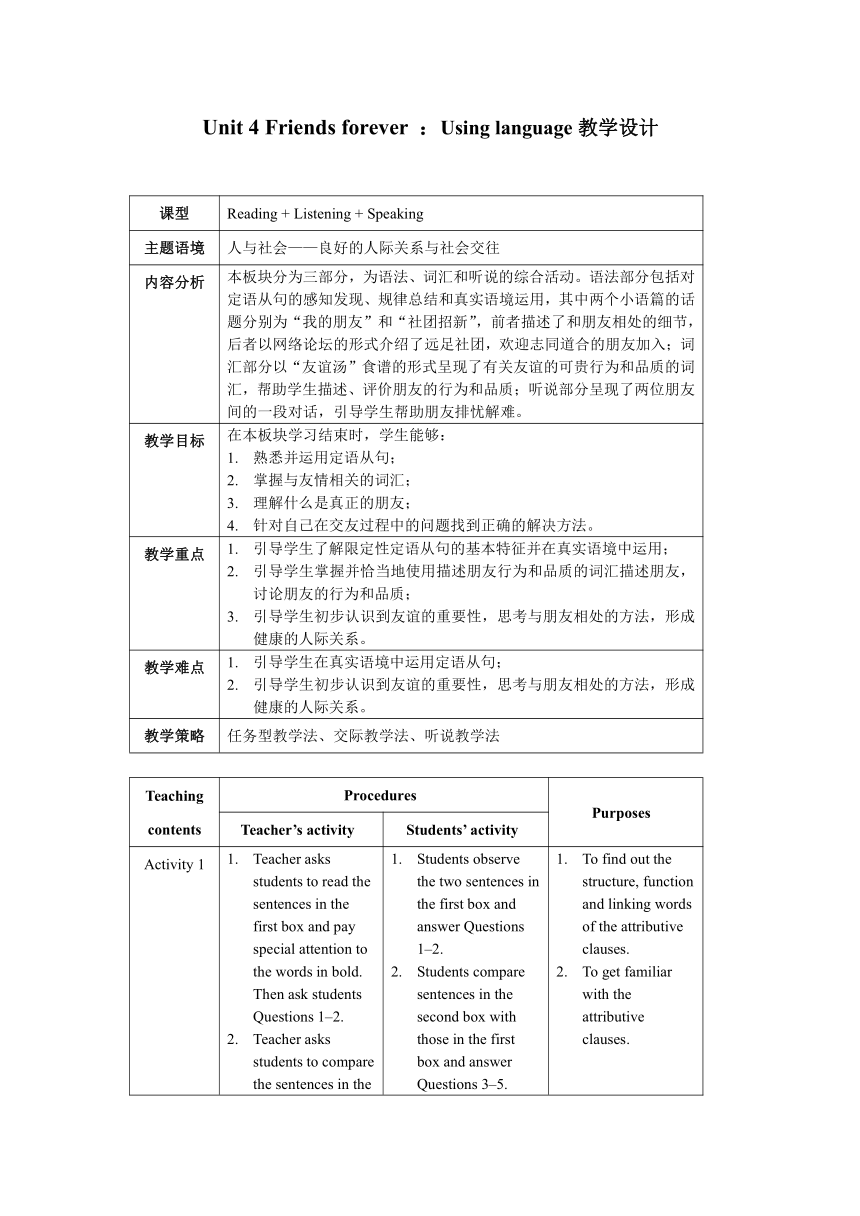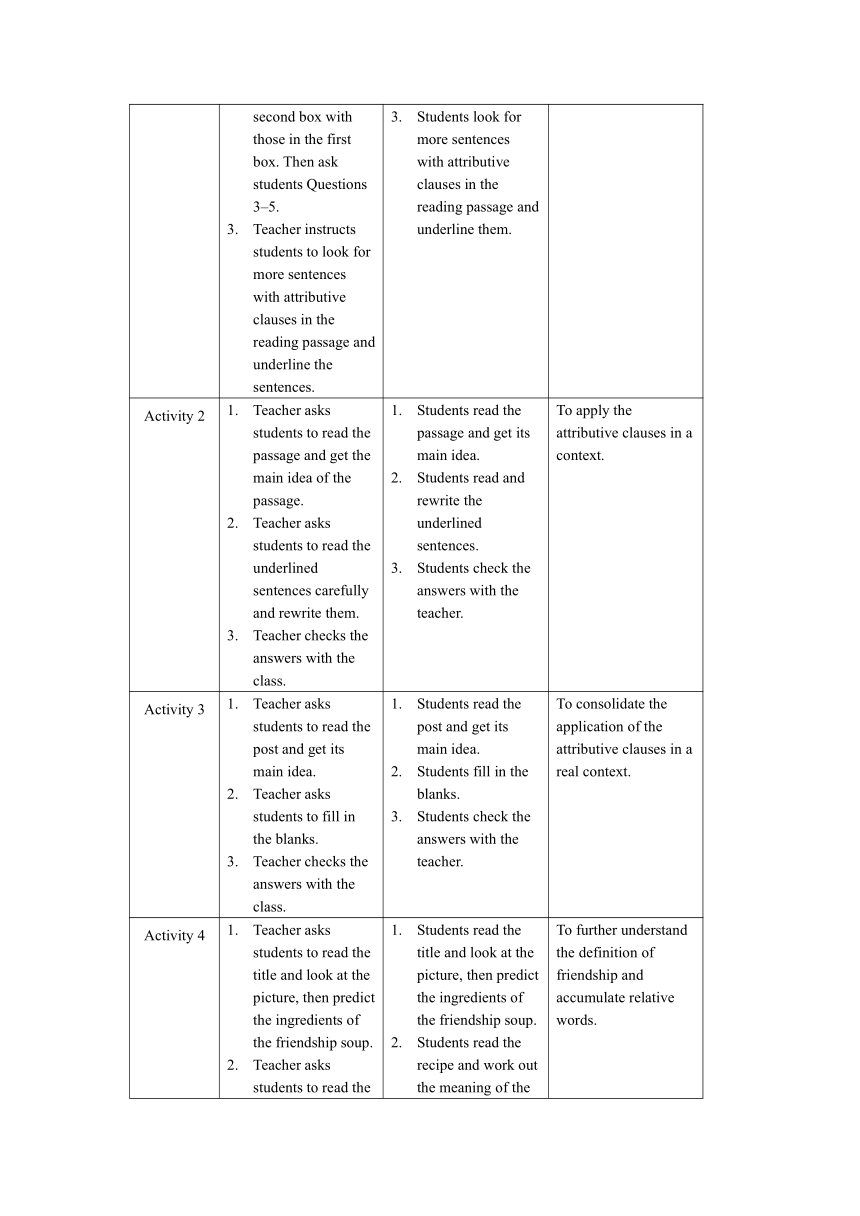外研版(2019)必修 第一册Unit 4 Friends forever Using language教学设计(表格式)
文档属性
| 名称 | 外研版(2019)必修 第一册Unit 4 Friends forever Using language教学设计(表格式) |  | |
| 格式 | docx | ||
| 文件大小 | 19.7KB | ||
| 资源类型 | 教案 | ||
| 版本资源 | 外研版(2019) | ||
| 科目 | 英语 | ||
| 更新时间 | 2025-06-07 21:25:57 | ||
图片预览


文档简介
Unit 4 Friends forever :Using language教学设计
课型 Reading + Listening + Speaking
主题语境 人与社会——良好的人际关系与社会交往
内容分析 本板块分为三部分,为语法、词汇和听说的综合活动。语法部分包括对定语从句的感知发现、规律总结和真实语境运用,其中两个小语篇的话题分别为“我的朋友”和“社团招新”,前者描述了和朋友相处的细节,后者以网络论坛的形式介绍了远足社团,欢迎志同道合的朋友加入;词汇部分以“友谊汤”食谱的形式呈现了有关友谊的可贵行为和品质的词汇,帮助学生描述、评价朋友的行为和品质;听说部分呈现了两位朋友间的一段对话,引导学生帮助朋友排忧解难。
教学目标 在本板块学习结束时,学生能够: 熟悉并运用定语从句; 掌握与友情相关的词汇; 理解什么是真正的朋友; 针对自己在交友过程中的问题找到正确的解决方法。
教学重点 引导学生了解限定性定语从句的基本特征并在真实语境中运用; 引导学生掌握并恰当地使用描述朋友行为和品质的词汇描述朋友,讨论朋友的行为和品质; 引导学生初步认识到友谊的重要性,思考与朋友相处的方法,形成健康的人际关系。
教学难点 引导学生在真实语境中运用定语从句; 引导学生初步认识到友谊的重要性,思考与朋友相处的方法,形成健康的人际关系。
教学策略 任务型教学法、交际教学法、听说教学法
Teaching contents Procedures Purposes
Teacher’s activity Students’ activity
Activity 1 Teacher asks students to read the sentences in the first box and pay special attention to the words in bold. Then ask students Questions 1–2. Teacher asks students to compare the sentences in the second box with those in the first box. Then ask students Questions 3–5. Teacher instructs students to look for more sentences with attributive clauses in the reading passage and underline the sentences. Students observe the two sentences in the first box and answer Questions 1–2. Students compare sentences in the second box with those in the first box and answer Questions 3–5. Students look for more sentences with attributive clauses in the reading passage and underline them. To find out the structure, function and linking words of the attributive clauses. To get familiar with the attributive clauses.
Activity 2 Teacher asks students to read the passage and get the main idea of the passage. Teacher asks students to read the underlined sentences carefully and rewrite them. Teacher checks the answers with the class. Students read the passage and get its main idea. Students read and rewrite the underlined sentences. Students check the answers with the teacher. To apply the attributive clauses in a context.
Activity 3 Teacher asks students to read the post and get its main idea. Teacher asks students to fill in the blanks. Teacher checks the answers with the class. Students read the post and get its main idea. Students fill in the blanks. Students check the answers with the teacher. To consolidate the application of the attributive clauses in a real context.
Activity 4 Teacher asks students to read the title and look at the picture, then predict the ingredients of the friendship soup. Teacher asks students to read the recipe and work out the meaning of the words in bold. Teacher invites some students to share the answers with the class and others make comments. Students read the title and look at the picture, then predict the ingredients of the friendship soup. Students read the recipe and work out the meaning of the words in bold. Some students share the answers with the class. Others make comments. To further understand the definition of friendship and accumulate relative words.
Activity 5 Teacher asks students to read the dictionary entries and pay attention to their features. Teacher asks students to match the words in bold in Activity 4 to the dictionary entries. Teacher invites some students to share the answers with the class. Students read the dictionary entries and pay attention to their features. Students match the words in bold in Activity 4 to the dictionary entries. Some students share the answers with the class. To further understand the relative words in Activity 4.
Activity 6 Teacher asks students to think about the keywords of their own “Friendship soup”. Teacher asks students to work in pairs and create their own recipe. Teacher encourages several pairs to show their recipes to the class. Students think about the keywords of their own “Friendship soup”. Students work in pairs and create their own recipe. Different pairs show their recipes to the class. To enlarge and review the vocabulary about the topic of friendship.
Activity 7 Teacher asks students to read the sentences and find out the purpose of the activity. Teacher plays the audio and asks students to number the events in the correct order. Teacher checks the answer with the class. Students read the sentences and find out the purpose of the activity. Students listen to the audio and number the events in the correct order. Students check the answer with the teacher. To train the skills of grasping the main idea of a conversation through listening.
Activity 8 Teacher plays the audio again and asks students to complete the table. Teacher checks the answers with the class. Teacher asks students to talk about how Andy and Clara give suggestions, and asks students to pay attention to “Learning to learn”. Students listen to the audio again and complete the table. Students check the answers with the teacher. Students talk about how Andy and Clara give suggestions, and pay attention to “Learning to learn”. To learn to understand the details of the listening material. To learn the ways of giving suggestions.
Activity 9 Teacher divides students into pairs and asks them to read the materials on Page 82 and Page 85 respectively. Teacher asks students to work in pairs and make the conversation according to the different materials. Teacher invites several pairs to act out their conversations in front of the class. Students work in pairs and read the materials on Page 82 and Page 85 respectively. Students work in pairs and make the conversation according to the different materials. Several pairs act out their conversations in front of the class. To apply the expressions of giving suggestions.
Activity 10 Teacher divides students into pairs and asks them to talk about a problem that has come up between friends. Teacher invites several pairs to act out their conversations in front of the class. Students work in pairs and talk about a problem that has come up between friends. Several pairs act out their conversations in front of the class. To further practise giving suggestions.
课型 Reading + Listening + Speaking
主题语境 人与社会——良好的人际关系与社会交往
内容分析 本板块分为三部分,为语法、词汇和听说的综合活动。语法部分包括对定语从句的感知发现、规律总结和真实语境运用,其中两个小语篇的话题分别为“我的朋友”和“社团招新”,前者描述了和朋友相处的细节,后者以网络论坛的形式介绍了远足社团,欢迎志同道合的朋友加入;词汇部分以“友谊汤”食谱的形式呈现了有关友谊的可贵行为和品质的词汇,帮助学生描述、评价朋友的行为和品质;听说部分呈现了两位朋友间的一段对话,引导学生帮助朋友排忧解难。
教学目标 在本板块学习结束时,学生能够: 熟悉并运用定语从句; 掌握与友情相关的词汇; 理解什么是真正的朋友; 针对自己在交友过程中的问题找到正确的解决方法。
教学重点 引导学生了解限定性定语从句的基本特征并在真实语境中运用; 引导学生掌握并恰当地使用描述朋友行为和品质的词汇描述朋友,讨论朋友的行为和品质; 引导学生初步认识到友谊的重要性,思考与朋友相处的方法,形成健康的人际关系。
教学难点 引导学生在真实语境中运用定语从句; 引导学生初步认识到友谊的重要性,思考与朋友相处的方法,形成健康的人际关系。
教学策略 任务型教学法、交际教学法、听说教学法
Teaching contents Procedures Purposes
Teacher’s activity Students’ activity
Activity 1 Teacher asks students to read the sentences in the first box and pay special attention to the words in bold. Then ask students Questions 1–2. Teacher asks students to compare the sentences in the second box with those in the first box. Then ask students Questions 3–5. Teacher instructs students to look for more sentences with attributive clauses in the reading passage and underline the sentences. Students observe the two sentences in the first box and answer Questions 1–2. Students compare sentences in the second box with those in the first box and answer Questions 3–5. Students look for more sentences with attributive clauses in the reading passage and underline them. To find out the structure, function and linking words of the attributive clauses. To get familiar with the attributive clauses.
Activity 2 Teacher asks students to read the passage and get the main idea of the passage. Teacher asks students to read the underlined sentences carefully and rewrite them. Teacher checks the answers with the class. Students read the passage and get its main idea. Students read and rewrite the underlined sentences. Students check the answers with the teacher. To apply the attributive clauses in a context.
Activity 3 Teacher asks students to read the post and get its main idea. Teacher asks students to fill in the blanks. Teacher checks the answers with the class. Students read the post and get its main idea. Students fill in the blanks. Students check the answers with the teacher. To consolidate the application of the attributive clauses in a real context.
Activity 4 Teacher asks students to read the title and look at the picture, then predict the ingredients of the friendship soup. Teacher asks students to read the recipe and work out the meaning of the words in bold. Teacher invites some students to share the answers with the class and others make comments. Students read the title and look at the picture, then predict the ingredients of the friendship soup. Students read the recipe and work out the meaning of the words in bold. Some students share the answers with the class. Others make comments. To further understand the definition of friendship and accumulate relative words.
Activity 5 Teacher asks students to read the dictionary entries and pay attention to their features. Teacher asks students to match the words in bold in Activity 4 to the dictionary entries. Teacher invites some students to share the answers with the class. Students read the dictionary entries and pay attention to their features. Students match the words in bold in Activity 4 to the dictionary entries. Some students share the answers with the class. To further understand the relative words in Activity 4.
Activity 6 Teacher asks students to think about the keywords of their own “Friendship soup”. Teacher asks students to work in pairs and create their own recipe. Teacher encourages several pairs to show their recipes to the class. Students think about the keywords of their own “Friendship soup”. Students work in pairs and create their own recipe. Different pairs show their recipes to the class. To enlarge and review the vocabulary about the topic of friendship.
Activity 7 Teacher asks students to read the sentences and find out the purpose of the activity. Teacher plays the audio and asks students to number the events in the correct order. Teacher checks the answer with the class. Students read the sentences and find out the purpose of the activity. Students listen to the audio and number the events in the correct order. Students check the answer with the teacher. To train the skills of grasping the main idea of a conversation through listening.
Activity 8 Teacher plays the audio again and asks students to complete the table. Teacher checks the answers with the class. Teacher asks students to talk about how Andy and Clara give suggestions, and asks students to pay attention to “Learning to learn”. Students listen to the audio again and complete the table. Students check the answers with the teacher. Students talk about how Andy and Clara give suggestions, and pay attention to “Learning to learn”. To learn to understand the details of the listening material. To learn the ways of giving suggestions.
Activity 9 Teacher divides students into pairs and asks them to read the materials on Page 82 and Page 85 respectively. Teacher asks students to work in pairs and make the conversation according to the different materials. Teacher invites several pairs to act out their conversations in front of the class. Students work in pairs and read the materials on Page 82 and Page 85 respectively. Students work in pairs and make the conversation according to the different materials. Several pairs act out their conversations in front of the class. To apply the expressions of giving suggestions.
Activity 10 Teacher divides students into pairs and asks them to talk about a problem that has come up between friends. Teacher invites several pairs to act out their conversations in front of the class. Students work in pairs and talk about a problem that has come up between friends. Several pairs act out their conversations in front of the class. To further practise giving suggestions.
